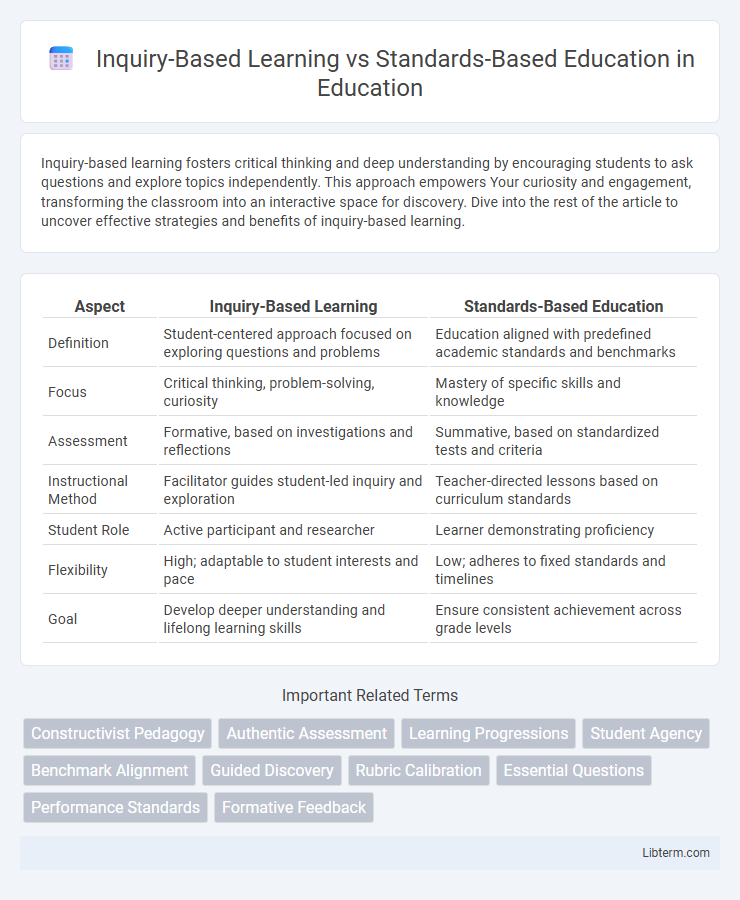Inquiry-based learning fosters critical thinking and deep understanding by encouraging students to ask questions and explore topics independently. This approach empowers Your curiosity and engagement, transforming the classroom into an interactive space for discovery. Dive into the rest of the article to uncover effective strategies and benefits of inquiry-based learning.
Table of Comparison
| Aspect | Inquiry-Based Learning | Standards-Based Education |
|---|---|---|
| Definition | Student-centered approach focused on exploring questions and problems | Education aligned with predefined academic standards and benchmarks |
| Focus | Critical thinking, problem-solving, curiosity | Mastery of specific skills and knowledge |
| Assessment | Formative, based on investigations and reflections | Summative, based on standardized tests and criteria |
| Instructional Method | Facilitator guides student-led inquiry and exploration | Teacher-directed lessons based on curriculum standards |
| Student Role | Active participant and researcher | Learner demonstrating proficiency |
| Flexibility | High; adaptable to student interests and pace | Low; adheres to fixed standards and timelines |
| Goal | Develop deeper understanding and lifelong learning skills | Ensure consistent achievement across grade levels |
Understanding Inquiry-Based Learning
Inquiry-Based Learning emphasizes student-centered exploration, fostering critical thinking and deep understanding by encouraging learners to ask questions, investigate, and construct knowledge through active engagement. This approach contrasts with traditional Standards-Based Education, which centers on meeting predefined learning objectives and benchmarks through structured content delivery. By prioritizing curiosity and hands-on problem-solving, Inquiry-Based Learning promotes adaptable skills essential for real-world application and lifelong learning.
Defining Standards-Based Education
Standards-Based Education defines clear, measurable learning goals that students must achieve at each grade level, ensuring consistency and accountability across educational systems. This approach emphasizes mastery of specific knowledge and skills aligned with state or national standards, allowing for targeted assessments and progress tracking. Teachers design curriculum and instruction to meet these predefined criteria, promoting uniformity in educational outcomes.
Core Principles of Inquiry-Based Learning
Inquiry-Based Learning centers on student-driven exploration, fostering critical thinking and problem-solving through questioning and investigation. Core principles include student curiosity as the catalyst for learning, active engagement in the research process, and reflection to deepen understanding. This approach contrasts with Standards-Based Education, which emphasizes predefined learning outcomes and assessment alignment to ensure mastery of specific skills and knowledge.
Key Features of Standards-Based Education
Standards-Based Education centers on clearly defined learning goals aligned with academic standards, ensuring consistent assessment of student progress through measurable outcomes. It emphasizes mastery of specific skills and content knowledge, guiding instruction and grading based on predefined criteria rather than comparative performance. This approach promotes transparency and accountability, providing educators and students with targeted feedback to support individualized learning paths.
Benefits of Inquiry-Based Approaches
Inquiry-Based Learning promotes critical thinking and deep understanding by engaging students in hands-on problem-solving and exploration, fostering intrinsic motivation and curiosity. This approach develops higher-order cognitive skills and adaptability, preparing learners for real-world challenges in dynamic environments. Compared to Standards-Based Education, Inquiry-Based Learning supports personalized learning paths and encourages collaborative knowledge construction, enhancing student ownership over their educational journey.
Advantages of Standards-Based Systems
Standards-based education provides clear, consistent benchmarks that enable precise measurement of student progress and ensure accountability across diverse classrooms. This system facilitates targeted instruction by identifying specific skill gaps, allowing educators to implement effective interventions tailored to individual student needs. By aligning curriculum, assessment, and instruction, standards-based education promotes equity and prepares students with essential competencies for academic and career success.
Challenges of Implementing Inquiry-Based Learning
Implementing inquiry-based learning faces challenges such as aligning open-ended student investigations with strict standards-based education requirements, which focus on measurable outcomes and standardized assessments. Educators often struggle to balance fostering critical thinking and creativity while ensuring students achieve predefined benchmarks in subjects like math and science. Limited resources, insufficient teacher training, and time constraints further complicate adapting curriculum for inquiry-driven instruction within standardized frameworks.
Drawbacks of Standards-Based Education
Standards-Based Education often limits teacher flexibility by enforcing rigid learning objectives, which can stifle creativity and reduce student engagement. It emphasizes measurable outcomes that may overlook critical thinking and problem-solving skills essential for real-world applications. This approach can also lead to teaching to the test, narrowing the curriculum and disadvantaging diverse learners who may not fit standardized criteria.
Inquiry vs Standards: Impact on Student Outcomes
Inquiry-Based Learning fosters critical thinking, problem-solving skills, and deeper understanding by encouraging students to explore concepts through questioning and hands-on activities. Standards-Based Education emphasizes mastery of predefined learning objectives, ensuring consistent knowledge acquisition and measurable academic progress across grade levels. Research indicates that combining inquiry approaches with clear standards can enhance student engagement and achievement by balancing creativity with structured goals.
Blending Inquiry-Based and Standards-Based Approaches
Blending inquiry-based learning with standards-based education enhances student engagement while ensuring mastery of essential skills outlined in standardized curricula. This hybrid approach fosters critical thinking and problem-solving by encouraging exploration within a clear framework of learning objectives and benchmarks. Integrating formative assessments aligned with standards allows educators to monitor progress and adapt instruction, balancing creativity with accountability.
Inquiry-Based Learning Infographic

 libterm.com
libterm.com